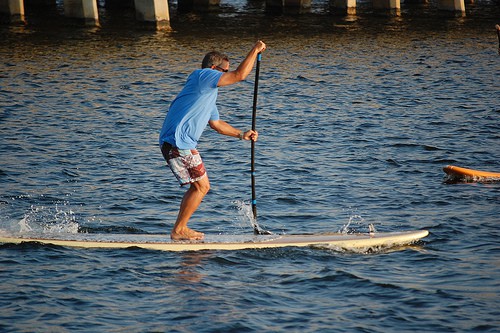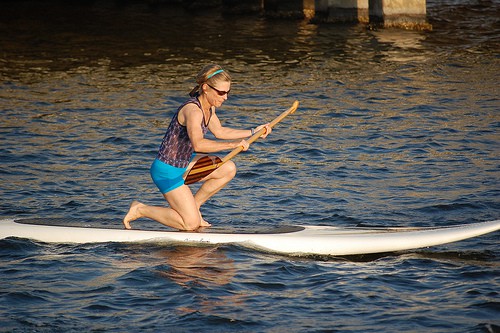SUPing, or stand up paddleboarding, is a great exercise to really work on flexibility, stability, and balance. Whether you’re paddling in fresh or ocean water, one key component of stand up paddleboarding is the stance.
Without the proper stance, you lack proper balance on the board and are more prone to fall down. Beginners can learn an easy stance for better stability and a more enjoyable SUP experience.
Best Stand Up Paddleboard Stance for Beginners
With any new sport, it’s always good to learn the proper technique from the get-go, so you don’t have bad habits to unlearn later. SUPing is no different.
Learning the best stance for beginners will not only make it easier for you to get started learning to stand up paddleboard, but it will also equip you to become a stronger stand up paddleboarder.
Many people learn to stand up paddleboard with their feet parallel and hip-width apart on the board. While this is the easiest stance to learn, it isn’t necessarily the best one.
When you keep the feet parallel on the board, you have great stability from side to side, but can easily be knocked off balance on your front-back axis. This means a lot more falling down for beginners.
The Staggered Stance
To have stability on both the front-back and the side axis, beginners should stand on the board with their feet hip-width apart and one foot slightly in front of the other.
The spacing should not be so wide as to be a surf stance. Just stagger the feet a few inches.
Check out some more great tips in this video:
This small shift in SUP stance allows you to regain your balance if a wave (or wake) hits at any angle. It can feel odd at first, especially if you have gotten used to SUPing with your feet hip-width apart and parallel.
However, it can really make you more stable on the board, and that can make your SUP sessions more enjoyable.
Locking your knees puts too much pressure on the back, so protect your back by keeping a slight bend in your knees.
Both your feet should point forward, and your head should look out toward the horizon. You’ll be more stable if you can keep your head and shoulders still, moving your hips and not your back to shift your weight. Anytime you need to move on the board, do so mindful of your balance.
Sudden movements that destabilize you are more likely to trigger a fall. Over time, you will feel more comfortable on the board.
Try Kneeling at First
Some newbies might find it easier to kneel on the board instead of stand. Kneeling puts you and your center of gravity closer to the water, offering more stability.
To SUP while kneeling, position yourself in the center of the board. Kneel on the board so that your knees are just behind the center line of the board. Then, raise yourself up, so your thighs are perpendicular to the board.
Even advanced SUPers might want to kneel at times when the wind and the waves become high.
To stand from a kneeling position, place the paddle across the board. Using your hands, push up into a standing position, taking care to distribute your weight evenly across the board. Avoid making sudden movements on the board, as this can affect your stability.
It’s OK to Fall!
Even with regular practice using this beginner SUP stance, you might fall occasionally. That’s part of the practice of learning to SUP. It happens to everyone, but having good form on the board (and using this stance) will keep your falls to a minimum!
SupBoardGuide Editorial Team
Latest posts by SupBoardGuide Editorial Team (see all)
- Best Inflatable Paddle Boards (iSUPs), 2025 - July 3, 2025
- Best Cheap Inflatable Paddle Boards (2025) - March 26, 2025
- SeaGods Carta Marina CX Review - January 31, 2025








Thank you, standing with feet staggered makes so much sense. I’ve been so frustrated from falling often.